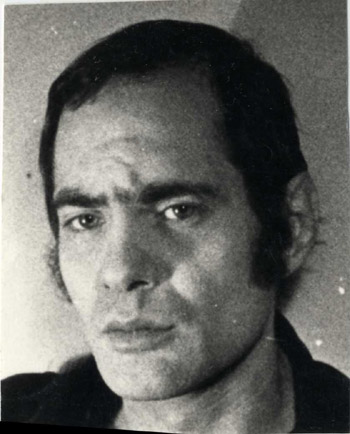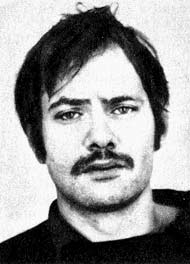<Back to Index>
- Chemist François Auguste Victor Grignard, 1871
- Painter Lorenzo Lippi, 1606
- Left Wing Militant Andreas Bernd Baader, 1943
PAGE SPONSOR



Andreas Bernd Baader (6 May 1943 – 18 October 1977) was one of the first leaders of the German left-wing militant organization Red Army Faction, also commonly known as the Baader - Meinhof Gang.
Andreas Baader was born in Munich on May 6, 1943. He was the only child of historian and archivist Dr. Berndt Phillipp Baader. Baader served in the German Wehrmacht, was captured on the Russian Front in 1945, and never returned. He was raised by his doting mother, aunt, and grandmother.
Baader was a high school dropout and criminal before his Red Army Faction (RAF) involvement. He was one of the few members of the RAF movement who did not attend a university. He was a narcissistic thrill seeker who was attracted by the criminality, violence and attention that joining such a group could offer him.
Before he joined the group, Baader made his money working as a "male model" for gay magazines, later working as a male prostitute or pimp as the mood took him. Although he didn't mind getting paid to have sex with gay men, he enjoyed leading on and then mocking or beating gay men who sought to have sex with him. This was to pay for his growing heroin addiction.
He briefly had a non-monogamous relationship with the painter Ellinor Michel (who
was married at the time), with whom he had a daughter named Suse in
1965. He left soon after and never tried to contact either of them
again. In 1968 Baader and his girlfriend Gudrun Ensslin were convicted of the arson bombing of a department store in Frankfurt am Main to
protest the public's "indifference" to the "genocide" in Vietnam.
DM 675,000 in damage was caused, and luckily no-one was injured or
killed (though it had been deliberately planned otherwise). After
being sentenced, Baader fled in November 1969. They were smuggled out
of West Germany by sympathizers and made the tour of the left-wing
communities of France, Switzerland, and Italy before sneaking back into
West Germany. Baader
was later caught at a traffic stop for speeding on 4 April, 1970. He
produced a fake driver's license in the name of famous writer Peter Chotjewitz, but was placed under arrest when he failed to answer personal questions like the names and ages of Chotjewitz's children. Ensslin masterminded an escape plan. Journalist Ulrike Meinhof and
Baader's lawyers concocted a false "book deal" in which Meinhof would
interview Baader. A few weeks later, in May 1970, he was allowed to
meet her at the library of the Berlin Zentralinstitut outside the prison, without handcuffs but escorted by two armed guards. Meinhof was allowed to join him. Confederates Irene Goergens and Ingrid Schubert entered
the library carrying suitcases, then opened a door to admit a masked
gunman armed with a pistol and then drew pistols out of suitcases. They
then fired shots that wounded a 64-year-old librarian, hitting him in
his liver. Baader, the masked gunman, and the three women then fled
through a window. The group soon became known as the Baader - Meinhof Gang, despite the fact that Baader was too scatterbrained and Meinhof too weak-willed to be the actual leaders of the group. Baader and others then spent some time in a Fatah military training camp in Jordan before
being expelled due to "differences in attitudes". For example, when
their trainers insisted their German guests attend training with the
rest of the students, they protested by going nude sunbathing on the
roof of their barracks. They seemed only interested in firing off
weapons and detonating explosive devices and repeatedly ignored safety
instructions. In one glaring example, Ulrike Meinhof almost blew
herself up with an anti-tank grenade during one field exercise (in
either a rash suicide attempt or a complete lack of any common sense.) Back in Germany, Baader robbed banks and bombed buildings from 1970 to 1972. Despite never obtaining a driving licence, Baader was obsessed with driving. He regularly stole expensive sports cars for use by the gang, and was arrested driving an Iso Rivolta IR300. On June 1, 1972, Baader and fellow RAF members Jan-Carl Raspe and Holger Meins were apprehended after a lengthy shootout in Frankfurt. From 1975 to 1977, a long and expensive trial took place in a fortified building on the grounds of Stuttgart's
Stammheim prison. According to reports from his jailers (including
Horst Bubeck), the defendants, especially Baader, kept their cells as
dirty and disgusting as possible in order to discourage searches for
items that might be smuggled in; at this time lawyers and defendants
were not separated by panes of glass during unsupervised meetings, as
evidenced by photos taken by inmates. However,
as a precaution against items being smuggled in, all prisoners were
strip-searched and inspected and given new clothes before and after
meeting lawyers. During a collective hunger strike in 1974, which led to the death of Meins, philosopher Jean-Paul Sartre visited Baader in Stammheim Prison where he was being held. He allegedly described Baader after the meeting as being an "idiot" ("Quel con !"). But, although he did not like Baader's behavior, he criticized the harsh conditions of imprisonment Baader endured. Meinhof
was found dead in her cell at Stuttgart - Stammheim on 9 May 1976,
hanging from the grating covering her cell window. Members of the Red
Army Faction and others claimed that she was killed by the German
authorities. The second generation of the RAF committed several
kidnappings and killings in a campaign in support of their comrades. The
three remaining defendants were convicted in April 1977 of several
murders, attempted murders, and of forming a terrorist organization, and were sentenced to life imprisonment. Militants tried to force the release of Baader and ten other imprisoned RAF members by kidnapping Hanns Martin Schleyer on 5 September 1977, as part of the sequence of events known as the "German Autumn", which began on 30 July 1977 with the murder of the banker Jürgen Ponto. However,
on 6 September 1977 an official statement was released in which the
state declared that the prisoners would not be released under any
circumstances, and on the same day a Kontaktsperre ("communication
ban") was enacted against all RAF prisoners. This order deprived
prisoners of all contact with each other as well as with the outside;
all visits, including those of lawyers and family members, were
forbidden. In addition, the prisoners were deprived of their access to
post, newspapers, magazines, television, and radio. The official
justification for this was a claim by the state that the prisoners had
supervised Schleyer's kidnapping from their cells with the assistance
of their lawyers. It was claimed that a hand drawn map had been found
which had been used in the kidnapping in Newerla’s car on 5 September.
On 10 September the prisoners' lawyers lost their appeal against the Kontaktsperre order and on 2 October it became effective. On 13 October 1977 four members of the Popular Front for the Liberation of Palestine hijacked Lufthansa Flight 181 on a flight from Palma de Mallorca to Frankfurt, their leader demanding the release of the eleven RAF prisoners detained at Stammheim. The aircraft was eventually flown to Mogadishu, Somalia,
where it arrived in the early hours of 17 October. The passengers of
the Boeing 737 were freed in an assault carried out by German GSG 9 special forces in the early hours of 18 October 1977 which saw the death of three of the militants. According
to official accounts of his death, Raspe learned of GSG 9's success on
a smuggled transistor radio, and spent the next few hours talking to
Baader, Ensslin, and Möller, who agreed to a suicide pact. In the
morning, Andreas Baader and Jan-Carl Raspe were found dead in their
cells, having died from gunshot wounds, while Gudrun Ensslin was found
hanging from a noose made from speaker wire. RAF member Irmgard Möller was found with four stab wounds to her chest, but survived. All
official inquiries on the matter concluded that Baader and his two
accomplices committed collective suicide, and Baader-Meinhof biographer Stefan Aust argued in the original edition of his book, The Baader-Meinhof Group (1985), that they almost assuredly did kill themselves. There
are many debatable aspects to the deaths: Baader was supposed to have
shot himself in the base of the neck so that the bullet exited through
his forehead; repeated tests indicated that it was virtually impossible
for a person to hold and fire a gun in such a way. In addition, three
bullet holes were found in his cell: one lodged in the wall, one in the
mattress, and the fatal bullet itself lodged in the floor, suggesting
that Baader had fired twice before killing himself. Finally, Baader had
powder burns on his right hand, but he was left-handed. Raspe, however,
showed no signs of powder burns. The
theory itself that guns had somehow been smuggled into Stammheim prison
depended on the testimony of Hans Joachim Dellwo (brother of prisoner Karl-Heinz Dellwo) and Volker Speitel (husband of Angelika Speitel).
Both had been arrested on 2 October 1977, and charged with belonging to
a criminal association; under pressure from the police they
subsequently admitted to acting as couriers and testified that they
were aware of lawyers smuggling items to the prisoners during the
trial. Their testimony was, however, tainted because they provided it
in order to avoid lengthy prison sentences and received reduced
sentences and new identities. In 1979 two defence attorneys were tried
and convicted for smuggling weapons. However, as noted above, the
lawyers had been unable to meet with their clients after 6 September
1977 due to the Kontaktsperre order. In
the revised version of his comprehensive book on the RAF, which
incorporates much new evidence and was published in English in 2009,
Stefan Aust is categorical that the group members committed suicide. Following their apparent suicides, the German government had the brains of Andreas Baader, Ulrike Meinhof, Gudrun Ensslin, and Jan-Carl Raspe removed for study at the Neurological Research Institute at the University of Tübingen. The results of Meinhof's brain study showed damage from an operation for a brain tumor in 1962. The results of the study of the others' brains are not known. Aside
from the removal of his brain, a death mask was made of Baader. The
brains of all but Meinhof have apparently been lost and cannot be
accounted for by German authorities.